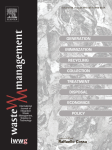Ver ítem
- xmlui.general.dspace_homeCentros e Institutos de InvestigaciónCICVyA. Centro de Investigación en Ciencias Veterinarias y AgronómicasInstituto de Microbiología y Zoología AgrícolaArtículos científicosxmlui.ArtifactBrowser.ItemViewer.trail
- Inicio
- Centros e Institutos de Investigación
- CICVyA. Centro de Investigación en Ciencias Veterinarias y Agronómicas
- Instituto de Microbiología y Zoología Agrícola
- Artículos científicos
- Ver ítem
Performance of semi-continuous anaerobic co-digestion of poultry manure with fruit and vegetable waste and analysis of digestate quality: A bench scale study
Resumen
Poultry manure (PM) can contain ammonium and ammonia nitrogen, which may inhibit the anaerobic process. The aim of this work was to evaluate the performance of anaerobic digestion of PM co-digested with fruit and vegetable waste. Two semi-continuous bench scale (19L) stirred tank reactors were used. The operating conditions were: 34.5 °C, 2 gVS/L.d (organic load rate), 28 d of hydraulic retention time and 100 revolutions per m (1 h × 3 times by day) for
[ver mas...]
Poultry manure (PM) can contain ammonium and ammonia nitrogen, which may inhibit the anaerobic process. The aim of this work was to evaluate the performance of anaerobic digestion of PM co-digested with fruit and vegetable waste. Two semi-continuous bench scale (19L) stirred tank reactors were used. The operating conditions were: 34.5 °C, 2 gVS/L.d (organic load rate), 28 d of hydraulic retention time and 100 revolutions per m (1 h × 3 times by day) for the agitation. The reactors were fed PM and a mixture of PM and fruit and vegetable waste (FVW) at equal proportions (based on wet weight). The performance of the anaerobic process was assessed through biogas and methane yields, reduction of organic matter, release of nitrogen compounds and the monitoring of stability indicators (pH, volatile fatty acids (VFA), total (TA) and partial (PA) alkalinity). Moreover, the digestate quality was evaluated to determine potential risk and benefits from its application as biofertilizer. Toxicity was assessed using Daphnia magna immobilization tests. Results showed that biogas and methane yields from PM-FVW were 31% and 32% higher than PM alone, respectively. Values of organic matter, pH, alpha (PA/TA) and VFA revealed that stability was approached in PM and PM-FVW. The co-digestion of PM with FVW led to the highest methane and biogas yields, lower FAN and TAN concentrations, and a better digestate quality compared to mono-digestion of this manure.
[Cerrar]

Autor
Bres, Patricia Alina;
Beily, María Eugenia;
Young, Brian Jonathan;
Gasulla, Javier;
Butti, Mariano;
Crespo, Diana Elvira;
Candal, Roberto;
Komilis, Dimitrios;
Fuente
Waste Management 82 : 276-284 (December 2018)
Fecha
2018
ISSN
0956-053X
1879-2456
1879-2456
Formato
pdf
Tipo de documento
artículo
Palabras Claves
Derechos de acceso
Restringido
 Excepto donde se diga explicitamente, este item se publica bajo la siguiente descripción: Creative Commons Attribution-NonCommercial-ShareAlike 2.5 Unported (CC BY-NC-SA 2.5)
Excepto donde se diga explicitamente, este item se publica bajo la siguiente descripción: Creative Commons Attribution-NonCommercial-ShareAlike 2.5 Unported (CC BY-NC-SA 2.5)

